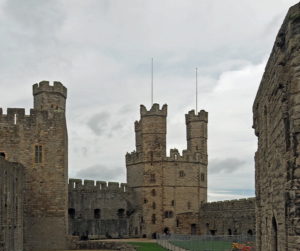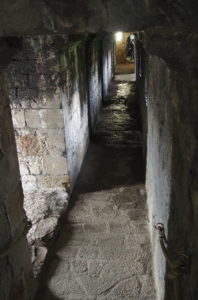Until Edward I decided to stamp his authority on Wales, Caernarfon was just a small Norman motte and bailey castle guarding the mouth of the River Seiont. Edward was responsible for building a ring of castles around Wales. All were designed by his military architect, James of St George. Not only were they a statement of Edward’s power, they were also state of the art military design.
Building began in 1283 and took 47 years at a total cost of £25,000. Existing buildings were cleared to build a new walled town next to the castle which was to become Edward’s administrative centre for Gwynedd. A new quay was built for building material brought in by sea.
The Eagle tower with its three turrets at the top was the first to be completed and was intended for the royal apartments. This was where Edward’s Son was born. In 1301 he was presented to the Welsh nobility as a prince ‘that was borne in Wales and could speak never a word of English”. This tale may well be apocryphal, as it can only be traced to the C16th. The tradition continued in 1969, when Queen Elizabeth II invested Charles as prince of Wales on the circular slate dais in the centre of the castle. The chair and kneeler used are now on display in the Eagle Tower.
Caernarfon Castle differs from the rest of Edward’s Welsh castles with its distinctively banded walls and polygonal rather than round towers. Arnold Taylor, who was Chief Inspector of Ancient Monuments and Historic Buildings and an international expert on European castle building, proposed a theory that the design of Caernarfon Castle was a representation of the walls of Constantinople. This was influenced by the legendary dream of Magnus Maximus (Macsen Wledig), a Roman emperor who married the daughter of a Welsh prince and founded a great dynasty. The mythology is explored in an exhibition in the Black Tower.
In his dream Maximus had seen a fort, “the fairest that man ever saw”, within a city at the mouth of a river in a mountainous country and opposite an island. Edward interpreted this to mean Caernarfon and its architecture reflects that of Roman sites of that time. Edward also had Welsh links from his grandfather, King John, who linked the family to the Welsh princes through a marriage agreement. By honouring Welsh mythology, Edward wanted to identify himself with the Welsh princes and establish his ‘right’ to rule.
Caernarfon continued as a major stronghold and administrative centre for North Wales until the end of the C15th when the accession of Henry Tudor who was of Welsh descent, led to diminished tension between the English and the Welsh. Caernarfon no longer had any strategic importance and was allowed to fall into a state of neglect. It did see some action during the Civil War when it was held by the Royalist before surrendering to the Parliamentary Forces. Cromwell ordered the castle to be slighted to prevent its further use, but fortunately these orders were never carried out.
By the C19th the castle was in a very poor state when state funds were used to restore the outer walls and towers.
From the outside, Caernarfon is impressive with its curtain wall and massive polygonal towers. With its interconnecting wall passageways and rampart walks it has been described as one of the most formidable concentrations of fire power of the Middle Ages.
It is a “long, narrow building”:http://en.wikipedia.org/wiki/Caernarfon_Castle#/media/File:Caernarfon_Castle_plan_labelled.png which was divided into the upper (east) ward which contained the Royal apartments, and a lower west ward. The intended range of buildings separating the two were never built.
Originally, as at “Conwy,”:https://www.silvertraveladvisor.com/review/attraction/153046-review-conwy-castle there would have been buildings along the walls but all that is left are foundations and a fireplace on the wall near the Eagle Tower. The castle was intended to be capable of accommodating the Royal household, constable and garrison.
The Eagle Tower, Queen’s Tower, Chamberlain Tower and Black Tower were all intended as accommodation with a central chamber on each floor surrounded by small rooms with latrines as well as a chapel. Narrow spiral staircases climb to the roof of the Eagle tower which has good views of the river and quayside.
The Royal Welch Fusilier’s Museum is housed in two of the towers and there are exhibitions and a film show in other towers.
Although the castle remains the property of the Crown, it is in the care of CADW and open daily apart from three days over Christmas and New Year’s Day.
DISABLED ACCESS
There is a wheelchair ramp from the street to the main entrance in King’s Gate. There is level access into and around the inner courtyard inside the castle are accessible but not the towers or walkways. Toilets are only accessible down a flight of metal steps.
Entry is free to disabled visitors and their carers.









